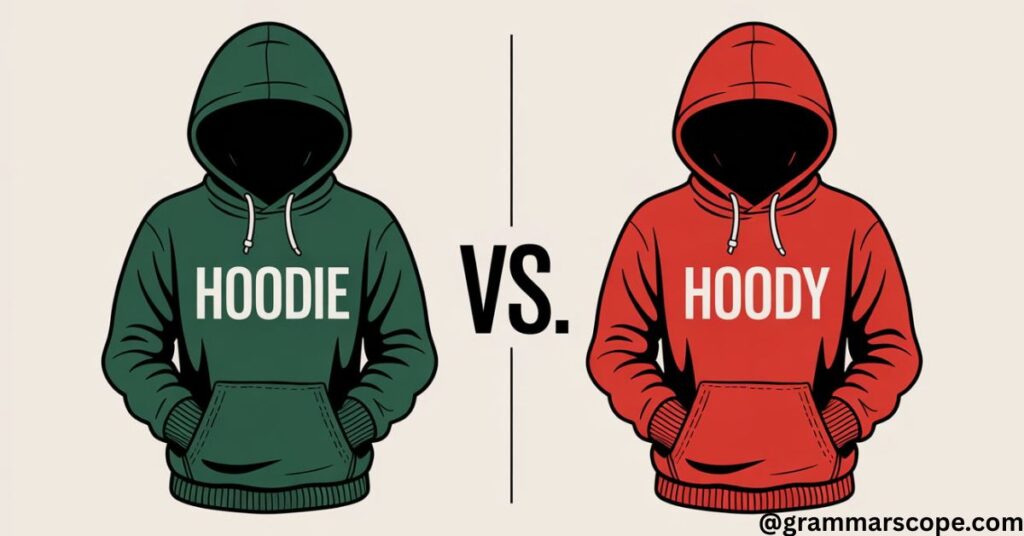Hoodie spelling has puzzled casual writers and fashion enthusiasts alike for years. That comfortable, hooded sweatshirt hanging in your closet the one with the kangaroo pocket you can’t live without comes with a spelling dilemma that’s more common than you might think.
The debate between “hoodie” and “hoody” isn’t just about preference; it reflects the evolving nature of language and how spelling conventions adapt over time. While many assume there’s a single “right” answer, the truth is more nuanced and depends on several factors including geography, context, and purpose.
As someone who’s wasted far too much time second-guessing whether to write “hoodie” or “hoody” in product descriptions, social media posts, and even text messages to friends, I’ve decided to dive deep into this cozy clothing conundrum once and for all.
Ways to Choose Between “Hoodie” and “Hoody”
- Use “hoodie” for formal writing, professional contexts, and global audiences
- Use “hoody” in casual communications or when appealing to Australian markets
- Follow the industry standard of “hoodie” for retail and fashion writing
- Check regional preferences when writing for specific geographic audiences
- Be consistent with your chosen spelling throughout a single document
- Consider “hoodie” as the safer choice since major dictionaries list it as the primary spelling
- Remember “hoodie” pluralizes to “hoodies” (simply add -s)
- Note that “hoody” pluralizes to “hoodies” (drop the y and add -ies)
- Match your company’s existing style guide and branding materials
- Use “hoodie” when writing for American or Canadian audiences
- Consider both spellings acceptable for informal contexts like text messages
- Follow major retailers’ lead – Nike, Adidas, and Champion all use “hoodie”
The Origins of Hooded Sweatshirts
Before tackling the spelling debate, let’s look at where this cozy garment came from. The hooded sweatshirt first appeared in the 1930s when Champion (then called Knickerbocker Knitting Company) developed them for laborers working in freezing temperatures in upstate New York.
The modern hoodie as we know it today—complete with its signature kangaroo pocket—became a wardrobe staple in the 1970s when hip hop culture embraced it. The term itself didn’t become mainstream until decades later, which partly explains the spelling inconsistencies we face today.
Hooded sweatshirts quickly transcended their practical origins to become cultural icons, symbols of both athletic achievement and counterculture rebellion. The spelling variations emerged as the garment itself evolved from purely functional workwear to fashion statement.
Hoodie vs. Hoody: The Core Differences

What Exactly Is This Garment?
A hooded sweatshirt, regardless of spelling, refers to a casual pullover or zip-up sweatshirt with an attached hood. Most feature a large front pocket (the kangaroo pocket) and are made from cotton, polyester, or blends of the two. Some have drawstrings at the hood and elastic cuffs and waistband for a snug fit.
These comfortable tops have become staples in wardrobes worldwide, worn by everyone from college students to tech CEOs. They’re prized for their comfort, versatility, and the way they bridge the gap between function and fashion.
The “Hoodie” Spelling
“Hoodie” is currently the preferred spelling in most English-speaking countries, especially in the United States, Canada, and the United Kingdom. This version follows the typical English pattern when adding “-ie” to words ending in “d” (like “foodie” or “roadie”).
The “-ie” ending often gives words a more familiar, affectionate quality, which might explain why this spelling has become more prevalent for this beloved garment. When major retailers, fashion magazines, and dictionaries use a particular spelling, it tends to reinforce that version as the standard.
Examples of “hoodie” in use:
- Product description: “Our signature hoodie features organic cotton and a relaxed fit.”
- Email to a colleague: “Hey Sarah, don’t forget it’s casual Friday tomorrow—perfect excuse to wear that new company hoodie!”
- Fashion blog: “The oversized hoodie trend shows no signs of slowing down this season.”
The “Hoody” Spelling
“Hoody” represents an alternative spelling that follows a different but equally valid English pattern. Words like “moody,” “bloody,” and “windy” all use the “-y” suffix, so extending this pattern to “hood” gives us “hoody.”
This spelling is more common in certain regions, particularly parts of Australia and sometimes in the UK. It’s also frequently seen in informal contexts like text messages, social media posts, and casual communications.
Examples of “hoody” in use:
- Text message: “Bringing my gray hoody to the beach for when it gets chilly later.”
- British retailer: “New men’s zip-up hoody collection now available in store.”
- Australian sports team email: “Team hoody orders must be placed by Friday.”
Which Spelling Is “Right”?

The Verdict on Correct Usage
When it comes to determining the right spelling between hoodie and hoody, context matters more than absolute rules. Both spellings are technically correct, though “hoodie” has emerged as the more universal spelling in recent years.
If you’re writing in a professional capacity, following style guides, or creating content for a global audience, “hoodie” is generally the safer choice. Most major dictionaries, including Oxford and Merriam-Webster, list “hoodie” as the primary spelling, with “hoody” as a variant.
Regional and Contextual Preferences
Spelling preferences often follow regional patterns:
- United States: Strongly favors “hoodie”
- United Kingdom: Generally uses “hoodie,” though “hoody” appears regularly
- Australia: More variation, with “hoody” being more common than in other regions
- Canada: Predominantly uses “hoodie”
Beyond geography, different contexts may call for different spellings across contexts:
In formal writing like academic papers, professional communications, or published works, “hoodie” is generally preferred. For example, a university professor writing about youth fashion would likely use “hoodie” in their research paper.
In informal contexts like text messages or casual emails between friends, either spelling works perfectly fine. When Jason messages his friend “Bringing a hoody for the campfire tonight,” no one would consider this incorrect.
Professional Communications and Branding
Business Context Considerations
For businesses selling these garments, consistency is key. Major brands like Nike, Adidas, and Champion consistently use “hoodie” in their product descriptions and marketing materials, establishing it as the industry standard in retail.
When writing business communications about this casual sweatshirt, it’s advisable to:
- Check your company’s style guide if one exists
- Be consistent throughout all materials
- Consider your target audience and their regional preferences
Email Examples in Professional Settings
Scenario 1: Company-wide announcement
Subject: New Company Branded Apparel Available
Dear Team Members,
I’m excited to announce that our new company-branded **hooded sweatshirts** are now available through the employee portal. These navy blue **hoodies** feature our updated logo and are perfect for our upcoming team building retreat. Each employee is entitled to one complimentary hoodie, with additional units available for purchase at $25 each.
Please submit your size request to Amanda in HR by Friday.
Best regards,
Michael Thompson
Director of Employee Experience
Scenario 2: Retail marketing email
Subject: Stay Warm & Stylish with Our New Winter Collection
Hey Taylor,
Beat the winter chill with our new lineup of **cozy garments**! Our bestselling **hoodie** collection has just been updated with fresh colors and improved fabric for extra comfort.
The **preferred spelling** might be “hoodie,” but we prefer to call them perfect! Featuring our signature **kangaroo pocket** design and organic cotton blend, these hoodies are ideal for everything from morning jogs to Netflix marathons.
Order within the next 48 hours to receive 15% off your purchase!
Stay warm,
The ComfortWear Team
Pluralization and Grammar Rules

Forming the Plural
Understanding pluralization rules is important when discussing multiple hooded sweatshirts. The plural forms follow standard English patterns:
- Hoodie becomes hoodies (simply add -s)
- Hoody becomes hoodies (drop the y and add -ies)
This difference in pluralization highlights why some might prefer “hoodie”—its plural form is more straightforward and intuitive to form.
Grammar Tips for Writers
When writing about these garments:
- Use “a hoodie” or “a hoody” with indefinite articles
- Use “the hoodie” or “the hoody” with definite articles
- For possessive forms, use “hoodie’s pocket” or “hoody’s zipper”
- Maintain consistent spelling throughout a single document
Pro Tip: In an article where spelling hoodie variants is your focus, consistency matters more than which variant you choose. Pick one spelling and stick with it throughout your text to avoid confusing readers or appearing careless.
Historical Evolution of the Term
The term “hoodie” (or “hoody”) didn’t become widespread until the 1990s, despite the garment existing for decades prior. Before this, they were simply called “hooded sweatshirts” or “hooded jackets.”
The abbreviated term gained popularity alongside the rise of hip-hop and skateboarding cultures, where the garment became an iconic fashion statement. By the early 2000s, hoodies had firmly established themselves in mainstream fashion vocabulary.
Interestingly, the spelling variation emerged during this transition to mainstream usage. Early references tended to use “hoody,” but as the garment gained prominence in retail and fashion media, “hoodie” became increasingly standardized.
Cultural Significance Beyond Spelling

The casual sweatshirt with a hood has transcended its humble origins to become a powerful cultural symbol. Beyond debates about correct spelling, hoodies represent comfort, casual style, and sometimes political statements.
In 2012, the hoodie became a symbol of protest following the shooting of Trayvon Martin. Politicians, celebrities, and activists wore hoodies in solidarity, highlighting how this simple garment carries deep cultural significance.
Tech culture has also embraced the hoodie, with figures like Mark Zuckerberg making it almost uniform in Silicon Valley. This shift helped elevate the humble sweatshirt from purely casual wear to acceptable attire in certain professional settings.
Making Your Choice: Practical Guidelines
When deciding between “hoodie” and “hoody,” consider these factors:
- Audience location: Consider regional preferences if writing for a specific geographic audience
- Formality level: For formal documents, lean toward “hoodie” as the more widely accepted form
- Brand consistency: Check existing materials if writing for an established brand
- Personal preference: In casual writing, either spelling is acceptable
Remember that language evolves, and what’s considered “standard” today may shift over time. The most important thing is clarity and consistency within a single piece of writing.
Frequently Asked Question
How do you spell hoodie or hoody?
The correct and more common spelling is “hoodie”. “Hoody” is a less common variant but still understood.
How do Americans spell hoodie?
Americans spell it “hoodie”, which is the standard and widely accepted spelling in the U.S.
What is the proper name for a hoodie?
The proper name for a hoodie is a hooded sweatshirt. It refers to a sweatshirt with an attached hood, often featuring a front pocket and drawstrings.
Is it hoodie or hooded sweatshirt?
Both are correct, but they differ slightly in formality and usage:
- “Hoodie” is the casual, commonly used term.
- “Hooded sweatshirt” is the formal or technical term, often used in product descriptions or retail.
How do you pronounce hoody?
“Hoody” is pronounced the same as “hoodie”:
/ˈhʊd.i/ — HUUD-ee
The spelling changes, but the pronunciation stays the same.
Conclusion: Comfort Trump’s Spelling
While the debate between “hoodie” and “hoody” will likely continue, most people care far more about the comfort of their favorite hooded sweatshirt than how to spell it. The right spelling ultimately depends on your audience, purpose, and context.
For most writers in most situations, “hoodie” represents the safer choice as the more universal spelling. However, “hoody” remains a perfectly acceptable variant, particularly in casual or regional usage.
Whatever spelling you choose, this beloved garment—with its kangaroo pocket and cozy hood—remains one of fashion’s most enduring and versatile items. Its appeal transcends linguistic debates, bringing comfort to wearers regardless of how they write about it.
So whether you’re typing “hoodie” or “hoody,” what matters most is the warmth, comfort, and style this iconic garment brings to millions of people worldwide. After all, language, like fashion, is constantly evolving—and there’s plenty of room for variation along the way.

Emma Olivia is an experienced blogger and the creative mind behind Grammar Scope. With a passion for language and years of writing expertise, she crafts engaging, informative content that simplifies grammar and writing tips for readers worldwide. Emma’s dedication to clear communication and love for the written word shine through every article she publishes, making Grammar Scope a trusted resource for language enthusiasts and learners alike.







